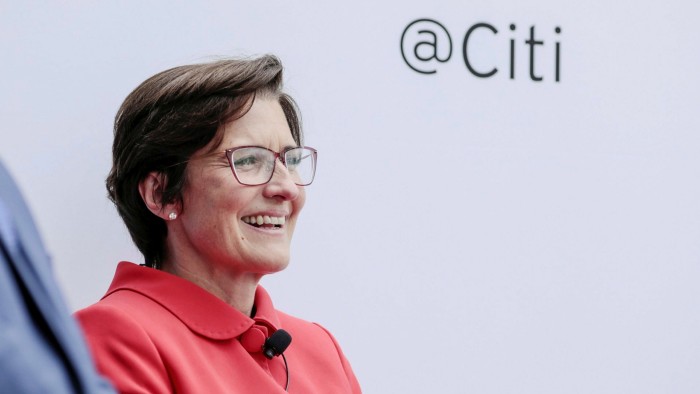How companies can ensure women get the top jobs, too

Roula Khalaf, Editor of the FT, selects her favourite stories in this weekly newsletter.
While a “glass elevator” has helped a few highly capable women reach top positions in leading companies in recent years, the “glass ceiling” is still stopping the majority from advancing.
Data for 2020 show that fewer than 6 per cent of the chief executives of S&P 500 companies are women, while the proportion of female executive or senior-level officials and managers is just over a quarter. In 2019, women held fewer than 30 per cent of senior leadership roles in FTSE 350 businesses.
Advances are still being made: last month, for example, Jane Fraser became the first female chief executive of a big Wall Street bank when she took over from Mike Corbat at Citigroup. Yet such breakthroughs also underline the progress still required — progress that the Covid-19 pandemic and homeworking can make harder to achieve.
Companies should persevere, however, and not just because of a commitment to equality. According to an analysis published in the Academy of Management Journal, greater female representation in senior posts is associated with reduced risk-taking and better overall financial performance in the long term.
Our research, co-authored with Peter Cappelli at the Wharton School, shows that some talented female executives at Fortune 100 companies have been promoted faster than their male counterparts, regardless of their roles, educational backgrounds and career histories. While such factors account in part for their rise, the women also moved through previous positions more quickly and skipped steps in the job ladder.
In other words, companies that have belatedly raised their game in recruitment, so that lower levels of the hierarchy are more diverse, do not necessarily have to wait for earlier cohorts to get out of the way before the higher levels can become equally inclusive.
Among the most effective practices to help women move ahead are sponsorship initiatives, such as the Breakthrough Leadership Programme at accountancy firm PwC and the Women in Leadership Sponsorship and Development Programme at broadcaster Sky. These foster the development of networks in the workplace, make the performance of women visible, and ensure that they gain access to challenging jobs.

Such broad-based initiatives may avoid one of the perverse consequences of ‘accelerated promotion’, when companies scramble to meet stakeholder demands to demonstrate diversity in their top ranks: once a female executive is appointed to a senior position, the pressure abates and the glass elevator stops working.
The coronavirus pandemic, however, poses a challenge for even the most progressive organisations. Women are likely to suffer more than men because much of the mentoring, coaching and development that helps them get ahead is harder to formalise and provide remotely. Teleworking restricts the scope for interpersonal networking and informal learning.
Women’s progress may also be hampered because they frequently take on most of the responsibilities at home. Working away from the office may make it easier in some ways to juggle professional and personal life, but it also increases the conflict between roles. As the principal caregivers in many households, it is harder for women than men to get their work done from home.
The danger is that women may end up curbing their ambitions or even abandoning their jobs entirely in the months ahead. One recent survey, carried out by McKinsey, the management consultancy, shows that more than one in four women are contemplating downshifting their careers or leaving the workforce — including those in leadership positions. Many are going part time.
Research in Canada also found that the gender employment gap for parents with young children widened considerably between February and May 2020, with women becoming more likely than men not to have a job. It grew still more for parents of elementary school-aged children than for those of preschoolers, and among less educated parents.
FT Online MBA ranking 2021 — top 15

Find out which schools are in our ranking of Online MBA degrees. Learn how the table was compiled and view a list of Online MBA programmes in our directory Also, read the rest of our coverage at www.ft.com/online-learning.
Well-meaningly or not, managers may hesitate to engage female colleagues in their teams’ most challenging projects. But such projects also tend to be the most interesting, and the result may be to reduce the motivation of the very women they are trying to help.
So what should companies do to support women at work?
Above all, our research shows that they can increase gender diversity at the top simply by promoting women faster or having them skip steps on the job ladder. But if this is to go beyond window-dressing, it needs to be a sustained policy, which means ensuring that programmes put in place before the pandemic are maintained. These must be adapted to recognise the realities of remote working, with efforts to ensure that women get access to the sponsorship they need.
Employers can also enable greater autonomy and flexibility. They may not be able to change the division of labour at home, but they can help women ease the difficulty of juggling schooling and caring responsibilities. Best practices include reimbursing additional day care and emergency childcare, new options for extended leave, and revising normal performance goals.
Ensuring that women get their share of leadership roles makes sense in terms of egalitarianism alone. But the consequences for corporate performance mean that there is a strong business logic too. Any setback to greater equality caused by the pandemic will slow economic recovery and reduce prosperity for companies and their stakeholders alike.
Monika Hamori and Rocío Bonet are associate professors of human resources and organisational behaviour at IE, which is the FT’s partner in executive development venture Headspring
Letter in response to this article:
Job sharing is one route to gender equality in C-suite / From Mary McCarthy, Dublin, Ireland
Comments